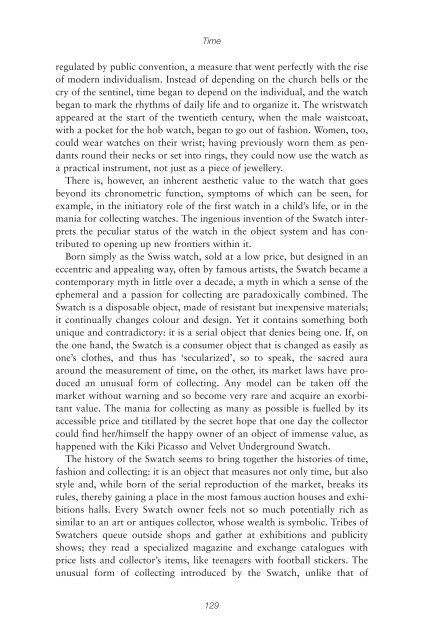You also want an ePaper? Increase the reach of your titles
YUMPU automatically turns print PDFs into web optimized ePapers that Google loves.
Time<br />
regulated by public convention, a measure that went perfectly with the rise<br />
of modern individualism. Instead of depending on the church bells or the<br />
cry of the sentinel, time began to depend on the individual, and the watch<br />
began to mark the rhythms of daily life and to organize it. <strong>The</strong> wristwatch<br />
appeared at the start of the twentieth century, when the male waistcoat,<br />
with a pocket for the hob watch, began to go out of fashion. Women, too,<br />
could wear watches on their wrist; having previously worn them as pendants<br />
round their necks or set into rings, they could now use the watch as<br />
a practical instrument, not just as a piece of jewellery.<br />
<strong>The</strong>re is, however, an inherent aesthetic value to the watch that goes<br />
beyond its chronometric function, symptoms of which can be seen, for<br />
example, in the initiatory role of the first watch in a child’s life, or in the<br />
mania for collecting watches. <strong>The</strong> ingenious invention of the Swatch interprets<br />
the peculiar status of the watch in the object system and has contributed<br />
to opening up new frontiers within it.<br />
Born simply as the Swiss watch, sold at a low price, but designed in an<br />
eccentric and appealing way, often by famous artists, the Swatch became a<br />
contemporary myth in little over a decade, a myth in which a sense of the<br />
ephemeral and a passion for collecting are paradoxically combined. <strong>The</strong><br />
Swatch is a disposable object, made of resistant but inexpensive materials;<br />
it continually changes colour and design. Yet it contains something both<br />
unique and contradictory: it is a serial object that denies being one. If, on<br />
the one hand, the Swatch is a consumer object that is changed as easily as<br />
one’s clothes, and thus has ‘secularized’, so to speak, the sacred aura<br />
around the measurement of time, on the other, its market laws have produced<br />
an unusual form of collecting. Any model can be taken off the<br />
market without warning and so become very rare and acquire an exorbitant<br />
value. <strong>The</strong> mania for collecting as many as possible is fuelled by its<br />
accessible price and titillated by the secret hope that one day the collector<br />
could find her/himself the happy owner of an object of immense value, as<br />
happened with the Kiki Picasso and Velvet Underground Swatch.<br />
<strong>The</strong> history of the Swatch seems to bring together the histories of time,<br />
fashion and collecting: it is an object that measures not only time, but also<br />
style and, while born of the serial reproduction of the market, breaks its<br />
rules, thereby gaining a place in the most famous auction houses and exhibitions<br />
halls. Every Swatch owner feels not so much potentially rich as<br />
similar to an art or antiques collector, whose wealth is symbolic. Tribes of<br />
Swatchers queue outside shops and gather at exhibitions and publicity<br />
shows; they read a specialized magazine and exchange catalogues with<br />
price lists and collector’s items, like teenagers with football stickers. <strong>The</strong><br />
unusual form of collecting introduced by the Swatch, unlike that of<br />
129

















